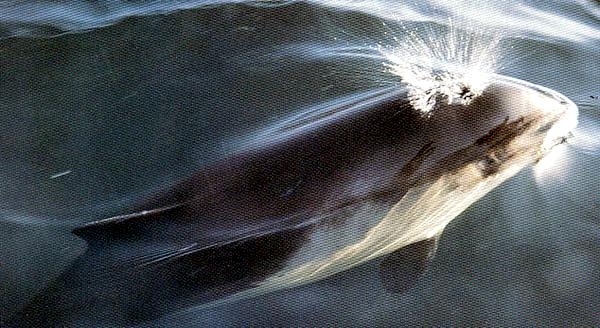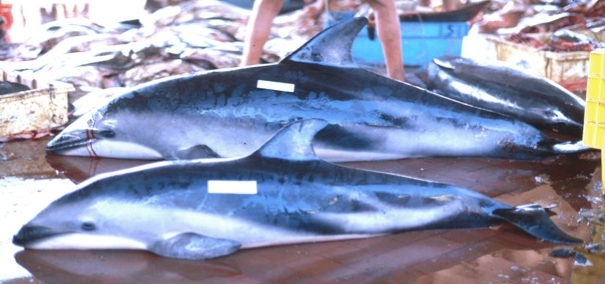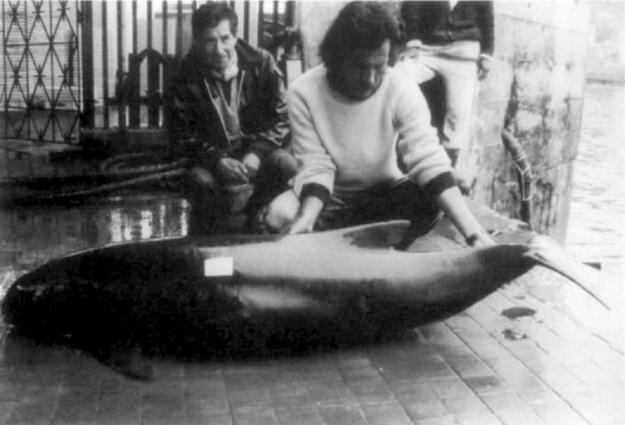“Phocoena spinipinnis”
The Burmeister’s Porpoise was first identified by the German zoologist Karl Hermann Burmeister in 1856. Although much has been learned in the more than 100 years since, this breed remains one of the least studied and most enigmatic members of the porpoise family. Like all porpoises, the Burmeister’s Porpoise lacks the elongated beak evident in most species of dolphin. One of the most distinguishing characteristics is the dorsal fin, which is set well back of the mid-body and carries a row of hard bumps on its forward edge. This porpoise’s dorsal fin has a longer, lower rise than the dorsal fins of dolphins or other porpoises. Another distinguishing feature is the marking stripes leading from each flipper back along the body are asymmetrical, being straight on the left side curved on the right. The dark eye patches common in porpoises are surrounded by pale-gray rings. This is one of the smaller porpoises, ranging from just about 1.5 to 2 yards in length and weighing from about 88 to 154 pounds. Though males tend to be slightly larger than females, the difference is not great enough to be relied on as a determining factor of its sex. Anchovies and hake are staples of this porpoise’s diet, along with several other types of fish, shrimp and squid. Off the Chilean coast, the Burmeister’s Porpoise has been recorded feeding on octopuses, snails and other mollusks. Not a flamboyant swimmer, this cetacean seldom breaches and can surface to breathe without greatly disturbing the water.
Capable of deep dives and swift speeds, Burmeister’s Porpoises are shy of boats and often seem to vanish as soon as they are noticed, making their social behavior extremely difficult to study. They are most often seen in pairs or in small pods of 6 to 8, yet pods as large as 70 have been spotted on occasion. Which of these social arrangements most accurately represents their typical social structure remains uncertain, as the presence of humans may significantly alter their natural behavior. Due to the shyness of the Burmeister’s Porpoise, breeding habits have not been extensively studied. Mating season is thought to last from June to September, followed by ten months of gestation, with calving season occurring from May through August. Calves are thought to be at least 27 inches in length at birth, with females reaching sexual maturity at about 61 inches and males at 63 inches. Burmeister’s Porpoises are native to South America, inhabiting the coastal waters off both the Atlantic and Pacific shores. On the Atlantic side, they are found from Rio de Janeiro all the way south to Tierra del Fuego, an area that includes the Falkland Islands. On the Pacific side, their territory begins farther north, along the northernmost coast of Peru and extends south around the tip of the continent. They have not been found outside this coastal region. Their preference is for cold, relatively shallow waters of about 500 feet deep or less and they sometimes wander into the very shallow waters of rivers and estuaries. It is uncertain whether they inhabit the entire coastline continuously or only territories along it. Aside from one natural predator the Killer Whale, man poses the biggest threat to this porpoise. They are among the cetaceans inadvertently caught in fishing nets and until the mid-1990′s, both Chile & Peru fishing industries shot or harpooned them, selling their meat for human consumption or for crab bait.



























